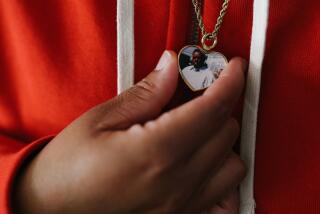Upsurge in Tuberculosis Cases Triggers Fear of a New Epidemic
- Share via
ALLENTOWN, Pa. — When Ricardo (Carl) Alexander died Dec. 17 of complications of tuberculosis, he could have been a textbook case.
The Lehigh County Prison inmate was 34. He was a drug user and, apparently, homeless. Born in Panama, he had lived in New York City, where he had also been in prison.
In Pennsylvania’s Lehigh Valley, where the man’s death at Allentown’s Sacred Heart Hospital of a pulmonary hemorrhage touched off fears of contamination and a call for testing among inmates and prison guards, Alexander’s case might seem an isolated occurrence, a fluke.
But to some, he is the tip of the iceberg.
For more than 30 years, American health officials thought they had tuberculosis under control. Thanks to drugs that can render an individual uninfectious within weeks and cured within months, the number of TB cases in the nation steadily declined until it reached about 22,000 a year.
But in 1986, the number of cases suddenly rose 2.6%. In 1988, the number of TB deaths jumped 12.3%.
Worse, the number of cases in certain areas--large cities, including New York, Newark and Miami--were running double, triple, even more than five times the national average.
Today, those numbers have some health experts talking about a new epidemic of the disease that at the turn of the century was America’s leading cause of death.
But these days, the victims are not people like poet John Keats, composer Frederic Chopin, Napoleon Bonaparte or Eleanor Roosevelt.
They are the urban poor.
“In reality, TB has never disappeared from the United States,” said Dr. Dixie Snider, head of the tuberculosis control division of the federal Centers for Disease Control in Atlanta. “It has (just) gone into focal pockets.”
According to Snider, those pockets are found disproportionately among minorities and lower socioeconomic groups. Two-thirds of American TB cases, and 85% of cases in children, he said, occur in minorities.
And while TB in Anglos is largely confined to the frail elderly, he added, in blacks and Latinos it has been increasingly affecting younger adults, predominantly males age 25 to 44.
The likelihood of contracting active TB is also much higher among the homeless. Recent immigrants from Southeast Asia and Latin America, where the disease is much more common and treatment less well-supervised, are also at higher risk, Snider said.
And TB is also much more common in prisons.
In fact, last year the CDC issued a report saying that the incidence of TB among prisoners is, on average, more than three times that of the general population.
In some prisons the incidence is much higher. In New Jersey, for example, the TB rate is 11 times higher for inmates. New York prisons had a sevenfold increase in the disease in the 10-year period ending in 1986.
“The number of cases has been increasing fairly dramatically in recent years in the state (prison) system,” said Kathy Pottler, an inmate advocate and director of the AIDS in Prison Project of the Correctional Assn. of New York.
TB has “also been increasing in New York City, so I don’t think it’s any surprise, given that nearly 80% of inmates are from New York City,” she added.
“One reason you may find prisoners with TB is that there’s a high-risk factor because they may have abused their bodies through drugs their entire lives and may come from low-income families, in which they don’t have access to basic medical care services,” said Allentown Health Bureau Director Gary Gurian.
According to the CDC, New York City reported 2,317 cases of TB in 1988, up from 2,197 cases in 1987. New York City Health Department spokesman Howard Reiser said there were 32.8 cases per 100,000 people in the city in 1988. That number is more than three times the CDC’s national average of 9.1 cases per 100,000.
In New York prisons, according to the CDC, most of the inmates infected with TB also carried HIV, the human immunodeficiency virus that causes AIDS.
And in fact, health officials said, the relationship of tuberculosis to AIDS may be the biggest reason for the recent sudden increase in TB cases and deaths.
According to Snider, many Americans--an estimated 10 million--have been exposed to the organism that causes TB at some time in their lives. But most of these people never show symptoms or pass on the disease because their immune systems keep them from getting sick.
But if the body is stressed so that the immune system does not work well, the TB germ comes out of hiding, Snider said.
HIV causes such a weakening in the immune system, health experts said.
“A lot of people with no problems in the past, if they get co-infected with HIV, they become an extremely high-risk group for developing TB,” said Dr. Lee Reichman, a professor and director of the Pulmonary Division of the University of Medicine and Dentistry of New Jersey in Newark and a spokesman for the American Lung Assn. “That’s really why we’re seeing all this increase.”
Reichman said a study of intravenous drug users he conducted in the mid-1970s--before AIDS became prevalent--showed they were much more likely to contract TB than members of the general population.
The high percentage of intravenous drug users among HIV-positive people largely accounts for the existence of TB in that group, Reichman said.
According to experts, once an individual has active TB, which manifests itself in a persistent cough and weight loss, he or she can spread the disease to others through the air by coughing.
However, it takes prolonged close contact--six months of eight-hour-a-day exposure or two months of 24-hour-a-day exposure, according to some experts--for an individual to have a 50% chance of contracting the disease.
More to Read
Sign up for Essential California
The most important California stories and recommendations in your inbox every morning.
You may occasionally receive promotional content from the Los Angeles Times.













